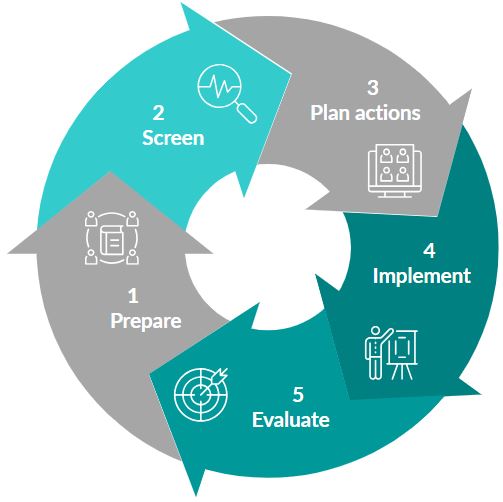How do we create healthy workplaces?
How do we create healthy workplaces?


The Five-Phase Model
Ready to embark on the journey to create a healthier workplace? Let's navigate your journey with five simple steps:
In the preparation and anchoring phase, embed mental health initiatives successfully by dedicating time to familiarise employees with upcoming changes and ensuring everyone has a common understanding of the goals and processes. Securing support, time, and resources from senior management – by explaining the importance of healthy workplaces – are crucial in this phase. Equally important is securing employees' buy-in, ensuring they are fully onboard and committed to the transformative journey ahead, and creating a cohesive and supportive environment for change. In this phase, it's also essential to have project champions with the right qualities and skills to drive this change successfully.
In the screening phase, conduct a thorough needs analysis (using diverse methods such as interviews, focus groups and/or surveys) to pinpoint where interventions are necessary in the workplace. This involves evaluating the work environment across the IGLO levels to determine what is working well and what needs improvement. Such deep insight into the environment leads to well-targeted interventions, directly addressing the root causes of identified issues. Summarise the needs from all organisational levels and share this feedback with all relevant stakeholders.
In the planning phase, leverage insights from the initial screening to identify necessary interventions. Involve employees in developing these interventions to ensure they meet their needs, fostering a sense of ownership and enhancing the fit with the organisational culture. Prioritise these interventions based on the identified needs, customising them to various organisational levels and ensuring compatibility with current policies. Align intervention goals with the identified needs while also considering organisational objectives. Formulate a comprehensive action plan (who, what, and by when), incorporating input from key stakeholders. Finally, define success metrics and establish regular intervals for evaluating progress.
Ensure someone leads during the implementation of interventions. Foster open dialogues with employees to understand their expectations, refining interventions according to their input. In these discussions, also share updates on intervention progress, outcomes attained, and any deviations from the (original) plans. This will help to keep the momentum going and ensure ongoing engagement and commitment from the workforce. Monitor the execution of interventions closely, checking for adherence to the plan, participation levels, and feedback. Address any unexpected challenges promptly, encouraging employees to apply new practices and securing managerial support for these implementations in daily tasks. Regularly report progress to the steering committee and other stakeholders and assess whether the interventions need fine-tuning based on these insights.
In the evaluation phase, the objective is to determine the effectiveness of the interventions. This requires a thorough analysis of the factors contributing to their effectiveness or any limitations encountered. Measure the impact of the interventions by comparing them with initial assessments and identify what was effective, for whom, and under what circumstances. Reflecting on the insights gained throughout this process guides the planning and execution of future initiatives.
While these steps logically follow one another, you might move back and forth between phases as the situation evolves and new insights emerge.
These steps are designed to be effective whether your initiatives aim to protect (i.e., safeguarding by detecting and eliminating risks) or promote (i.e., building health and well-being through resources) mental health.
To learn more about this five-phase model, join Anna and Peter on their inspiring journey:
Key Reflections for Each Stage of Building a Healthier Workplace
As you progress through each stage of developing a healthier workplace, reflect on these key points:
- Preparation and anchoring: Have we established a steering committee and communicated essential information? Do we have support, and do we have a change champion?
- Screening: Have we used diverse methods to assess the psychosocial environment, involving stakeholders at all levels? Have we shared the findings across the organisation?
- Action planning: Have we prioritised the interventions based on identified needs and integrated them with existing policies and practices? Do we have a detailed action and evaluation plan?
- Implementing interventions: Are we monitoring the implementation of our interventions? Have unforeseen challenges arisen?
- Evaluation: Have we seen any impact from these interventions? Have we explored the reasons behind these outcomes, identifying who was affected and how? What lessons have we learned?

